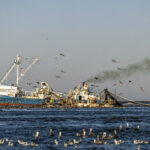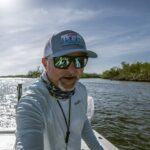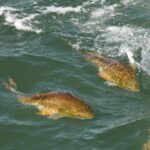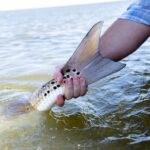Feature Photo: Luyen Chou, Founder of the GotOne App
WRITTEN COMMENT DEADLINE: FRIDAY, DECEMBER 22, 2023
SUBMIT EMAILS TO COMMENTS@ASMFC.ORG
SUBJECT LINE: “STRIPED BASS DRAFT ADDENDUM II“
After a brief break from the politics of fish and a full season chasing epic bites, the time to don our advocacy hats and protect our saltwater resources has returned. ASMFC just released the final version of Draft Addendum II for Striped Bass for public comment. The goal of this document is to reduce fishing mortality by adjusting recreational measures and commercial quotas in the ocean and Chesapeake Bay regions. While we strongly supported the initiation of Addendum II, we believe that the potential outcomes of this action are not enough to ensure long-term striped bass sustainability and abundance. These measures may only be in effect for the 2024 fishing year, assuming a 2024 stock assessment warrants another management action. Five consecutive years of poor spawns out of the Chesapeake Bay should be on everyone’s minds as we consider Draft Addendum II and the future of this fishery.
After the Striped Bass Board approved this document at the ASMFC Annual Meeting, ASGA began reviewing notes, talking with partners up and down the coast, and drafting positions for Draft Addendum II. In the coming weeks, ASMFC will be holding virtual and in-person hearings from New England down through Virginia to collect public comment on this document. The deadline for public input is December 22nd, 2023, so be sure to look into the options within Draft Addendum II and share your perspectives before the clock runs out. The following provides a summary of our positions and a template to guide your public comments.
Draft Addendum II—How to Comment
- ASMFC Draft Addendum II Web Page
- Meeting Schedule: Remember, you can attend any of the virtual or in-person meetings, regardless of where you actually reside.
- November 15th, New Jersey, virtual.
- November 16th, Connecticut, in-person.
- November 28th, Delaware, hybrid.
- November 30th, Rhode Island, hyrbid.
- November 30th, Connecticut, in-person.
- December 4th, New York, in-person.
- December 5th, New Jersey, in-person.
- December 5th, Massachusetts, in-person.
- December 6th, Maryland, in-person.
- December 7th, Virginia, in person/listen only live stream.
- December 11th, New Hampshire, hybrid.
- December 12th, Potomac River and DC, virtual.
- December 14th, Maine, hybrid.
- December 18th, New York, in-person.
- December 19th, Massachusetts, in-person.
Public Comment Guide on The Guide Post Podcast – Listen in Audio Format
ASGA Draft Addendum II Positions
3.1.1 Ocean Recreational Options: Option B—1-fish at 28-31″ with 2022 seasons (all modes).
- Let’s face it, recreational anglers harvested way too many fish in 2022, as the strong 2015 year-class recruited into the then 28-35” slot limit. ASGA supported the Emergency Action measure, and we still do. It is critical that managers continue efforts to protect the 2015 year-class and maintaining the 28-31” slot achieves that goal, while providing some consistency for anglers and the stock assessment scientists.
- We do not support mode splits. The Recreational sector (private and charter/for-hire) should continue to be managed under the same regulations.
- These measures will likely only be in place for just next year; the 2024 Striped Bass Stock Assessment Update is scheduled for late-2024, and another management action is probable. In other words, there is a good chance that the assessment shows us that additional actions will be required in order to successfully rebuild striped bass SSB by the 2029 deadline.
3.1.2 Chesapeake Bay Recreational Options: Option B1—1 fish at 19-23” across all CBAY jurisdictions with the same 2022 seasons.
- After five consecutive years of poor spawning success, the Chesapeake Bay region is in desperate need for conservation and precautionary fisheries management. ASGA supports Option B1 for many of the same reasons applicable to the ocean, but now the Bay’s recreational fisheries need to contribute to conservation. If the Ocean fishery can have a 3” slot, then the Chesapeake can deal with a 4” slot.
- Mode splits in the Bay should be fiercely opposed. Through previous conservation equivalency proposals, Maryland implemented a program to allow Charter/For-Hire passengers the ability to harvest two striped bass compared to one fish for the rest of the recreational sector. Maryland’s Chesapeake Bay for-hire fleet harvested 142,098 stripers; the coastwide total for the for-hire fleet was 281,289 fish. By giving Maryland’s charter fleet two fish, they harvested more than the rest of the Bay and the ocean combined. This is what happens when a state agency picks favorites.
- Option B1 would place all of the Chesapeake’s jurisdictions under the same size and creel limit, achieving far greater consistency across the region.
- Also, the 23” max will add a layer of protection for the average 2017- and 2018-year classes which will still have some presence in the bay. The current maximum size in MD would still allow harvest of these valuable fish. The proposed 19-23” slot would avoid these fish.
3.2.1 Commercial Quota Reduction Options: Option B with a 14.5% reduction to both the Ocean and Chesapeake Bay Quotas.
- Before we go any further, understand that this option may be entirely meaningless—unless states take matters into their own hands. For one, due to quota underutilization, a reduction in quota does not guarantee an actual reduction in fishing mortality—the ocean region has been using most of its quota in recent years and will see a reduction in fishing mortality; the Chesapeake Bay will not see much of any reduction with a 14.5% quota cut. Second, there are huge question marks around when states would even implement these changes. Doesn’t it seem disingenuous when certain states wait until the last minute to claim that implementing these commercial changes in 2024 would not be possible? We have a hard time buying this. Yes, commercial landings accounting is far more robust than in the recreational sector. But, if Maryland really wanted to take part in meaningful conservation, they would work through the challenges and issue new tags and IFQs for 2024. Don’t hold your breath.
- Another piece of context is to distinguish the Ocean and Chesapeake commercial fisheries, because in general, ASGA is not opposed to commercial fishing. The Ocean commercial fishery has taken all the reductions placed on the recreational sector, with the Emergency Action being the only outlier.
- The Chesapeake Bay has not taken a meaningful reduction since 2015. The Chesapeake commercial quota has taken a whopping 1.8% reduction (see below).
- Since 2020, Chesapeake Bay quota utilization hovered around 80%. This is concerning on multiple fronts: there are clearly not enough fish in the system AND quota reductions less than 20% will have zero impact.
- The 14.5% reduction is off the quota, not landings (the amount of fish harvested commercially). That means once again the Chesapeake Bay commercial fishery will not do their part to restore striped bass, as landings could be the same as last year.
- ASGA is supporting Option B with a 14.5% reduction to both fisheries.
- Do we think the Bay’s cut should be greater or specifically target landings? Of course we do, but that is not an option in this document. Remember, to be an effective advocate you need to support options that are being considered.
- We will be reaching out to each state to determine whether they can implement these commercial management changes in 2024.
3.3 Response to Stock Assessment: Option B—Board Action.
- Remember, the above options will likely only be effective for 2024 (and if at all on the commercial side), so this option may have the greatest impact on striped bass management. Next fall (likely at the 2024 Annual ASMFC Meeting), the Striped Bass Board will see the results of a new stock assessment update. We won’t speculate much other than by saying this string of poor recruitment is going to have a significant impact on the rebuilding projections, and additional management changes are needed to improve the odds of rebuilding by 2029. This option would allow the Board to move quickly to implement those new management measures through a simple majority. Without the Board action provision, the management process could take up to a year to respond.
- Public input, while not formalized through a management action, is not precluded by this option. ASGA regularly communicates with SB Board Members to share our perspectives on management. You can too. Get to know your respective Board Member, ask them questions, share with them how you want this fishery to look like in 12 years. It is Important. In this day and age, public involvement is as easy as ever.
There you have it. The ASGA team thoughtfully considered every dynamic possible when examining options for Addendum II. Our final positions reflect our grave concern for this fishery and a strong desire to do what is needed in the short-term in order to have an abundant stock and sustainable fisheries in the long-term.
Stay tuned for podcasts, more infographics and future information on social media channels about Draft Addendum II. Also, be sure to check the public hearing schedule and pick out a hearing that best fits your schedule. Finally, if you have any questions about this document or process, please reach out. You can direct message us any time on social media or email info@saltwaterguidesassociation.org. Who knows – we may just answer your question on a podcast and award you with a brand new pair of Costa Sunglasses.







22 Responses
Need to close the season from November 1,- April 15 way too many fish being killed in the Housatonic River
You have a date for the Connecticut Striped Bass meeting as – November 40th
I believe there was already a meeting on Nov 16th.
Pete,
So sorry about the typo
11/30!
http://www.asmfc.org/calendar/11/2023/CT-Public-Hearing-on-Striped-Bass-Draft-Addendum-II/2247
The Massachusetts commercial quota should be reduced to whatever extent possible. This not and rarely ever has been a fishery utilized by full time commercial fishermen. This is a fishery occupied by normal working people that own a center console who take advantage clustered fish groups to make some easy extra money. These people are not dependent on income from fishing. Any reduction in the harvestable quota would have very little economic impact for the state and the people.
I am in Florida for the winter..How can I send written comments. I am a summer resident of Kittery Maine. I fish the Piscataqua river and the near shore from Cape Ann to the Nubble, York Maine.
See instructions on the calendar in this link!
http://www.asmfc.org/calendar/11/2023/CT-Public-Hearing-on-Striped-Bass-Draft-Addendum-II/2247
As a RI surf fishermen I’m strongly in favor of the 28-31” slot limit. Only problem is there isn’t enough officers to enforce the rule. Many over slot fish are still taken in plain view with no consequences to worry about!
Make the fine $1000.00 per fish. Give $500 to DNR officer,$300 to state to have judges to inforce law, $100.00 to fund a project for clean water of that state and $100.00 to CCA or any organization to cleanup the Chesapeake Bay .I know $500 to some to DNR ,but they would have to work nites ,stakeout cars parking ,boat docks Example Cape Cod canel I see it also daylight blitz people running fish to cars. People taking videos and license plates and DNR officer shows up 11am people turn over info and I see these same poachers fishing later in wk. it would all stop if the $1000 a fish plan were adopted.
True in Cape Cod canal also! sadly!
100% C&R
I fished across the board from Massachusetts to the Chesapeake for over 30 years still doing it. I love these fish and only these fish. It’s a shame that we don’t have a standard rule in the waters that these fish swim in. Making it safe for these bass no matter where they go. I reside in New Jersey where we do not have a commercial fishery, but plenty of access for recreational people to get their own striped bass for dinner fresh daily.
I live in Staten Island NY. A few occasions that i actually was present
this fall for blitzing bass on the beach
obvious organized poaching took place. A certain ethnic group had women standing by with bags while the men fished. Any and all sized fish by many men were thrown into bags and run up to auto trunks by women.
I never witnessed such coreographed
Illegal activity. This went on as long as the fishing was frantic and moved down the beach. I saw this on several days. We need enforcement big time.
I’m sure they are not registered either. I tried saying something and all of a sudden they didn’t speak English. So frustrating. Handcuffs, fines and take their crummy gear.
The Massachusetts commercial quota should be reduced to whatever extent possible. This not and rarely ever has been a fishery utilized by full time commercial fishermen. This is a fishery occupied by normal working people that own a center console who take advantage clustered fish groups to make some easy extra money. These people are not dependent on income from fishing. Any reduction in the harvestable quota would have very little economic impact for the state and the people.
all in favor of 28″to 31″slot fish for everyone
Make a sport fish!!
I’m a RI resident that fishes RI , MA and CT. I work for a company that makes lures especially targeting Stripped Bass . Hog Island Lures , LLC. We have decided to change all our tail hooks to single inline hooks this coming year. Fish mortality after release has to be considered more.
We also offer a hookless flag for tails of our Cape Cod Canal lures. I support the slot of 28-31″ till data indicates we can change
Exactly any plug used should not carry more than one treble !!!
Nice to see some people moving in the right direction …..
Keep the 28”-31” slot in MA and cut the MA commercial quota as much as possible. At least in Boston Harbor, the commercial fishing days are just slaughtering the big female breeders. It’s hard to watch so many big fish get the gaff knowing that the future of the fishery is in the balance. Again, keep the slot at 28”-31” and lower the commercial quota as much as possible. No one in the state depends on it to put food on the table and there are less destructive ways to make some extra cash.
Being an NJ surf fisherman the past few years have been great and have been something I’d like to see long into the future and in many other states that these fish travel through. I support the 28”-31” slot, I also believe the season should be closed to harvest during the spring while these fish come to backwaters to spawn in large numbers where harvest can largely effect fish stock of present and future years to come. Also believe that having officers to enforce the laws that we depend on to keep our fishery intact is extremely vital.
1). Classify Striped Bass as a sport fish.
2). Standard regulations for the entire east coast fisheries from NC up to Maine.
3). No Kill until 2035